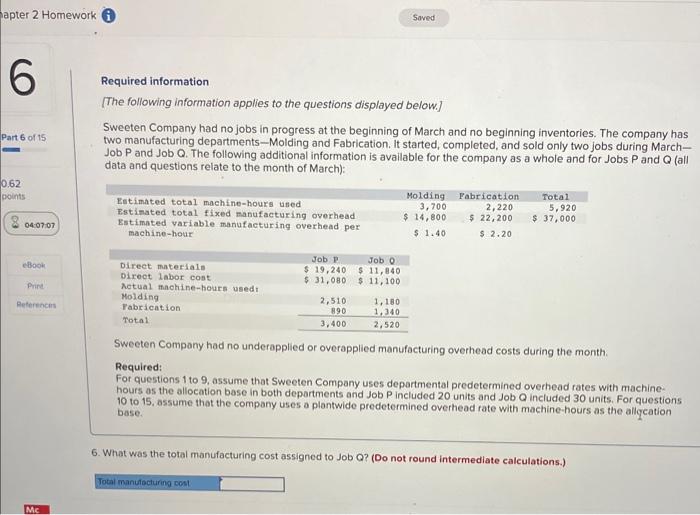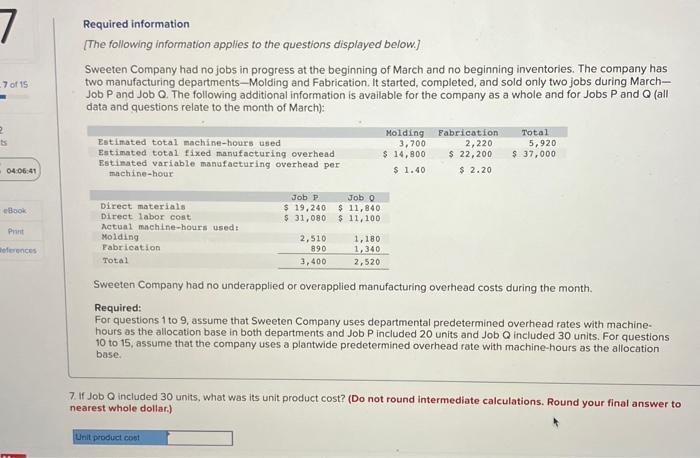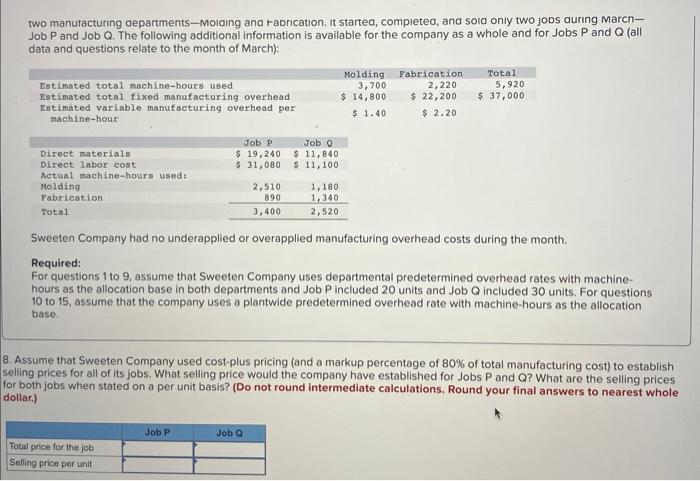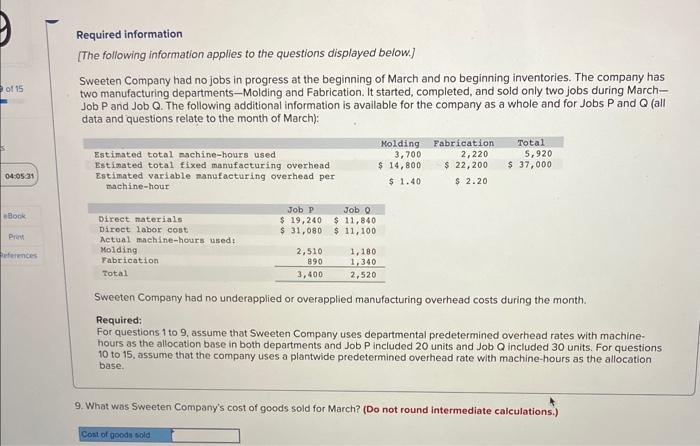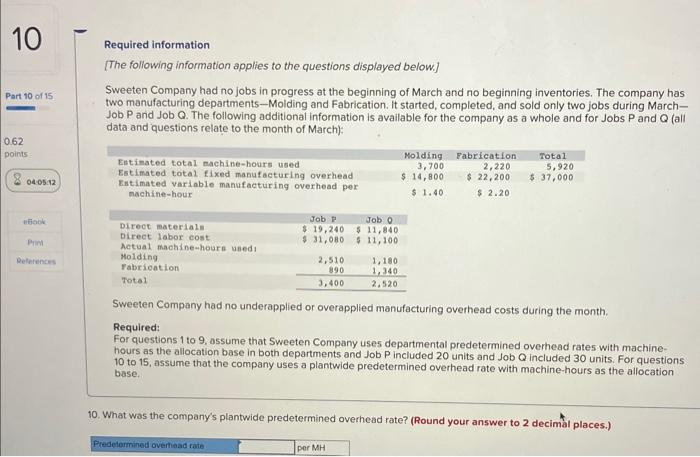Required information [The following information applies to the questions displayed below.] Sweeten Company had no jobs in progress at the beginning of March and no beginning inventories. The company has two manufacturing departments-Molding and Fabrication. It started, completed, and sold only two jobs during March Job P and Job Q. The following additional information is available for the company as a whole and for Jobs P and Q (all data and questions relate to the month of March): Sweeten Company had no underapplied or overapplied manufacturing overhead costs during the month. Required: For questions 1 to 9 , assume that Sweeten Company uses departmental predetermined overhead rates with machinehours as the allocation base in both departments and Job P included 20 units and Job Q included 30 units. For questions 10 to 15. assume that the company uses a plantwide predetermined overhead rate with machine-hours as the allqcation base. 6. What was the total manufacturing cost assigned to Job Q? (Do not round intermediate calculations.) Required information [The following information applies to the questions displayed below.] Sweeten Company had no jobs in progress at the beginning of March and no beginning inventories. The company has two manufacturing departments-Molding and Fabrication. It started, completed, and sold only two jobs during MarchJob P and Job Q. The following additional information is available for the company as a whole and for Jobs P and Q (all data and questions relate to the month of March): Sweeten Company had no underapplied or overapplied manufacturing overhead costs during the month. Required: For questions 1 to 9, assume that Sweeten Company uses departmental predetermined overhead rates with machinehours as the allocation base in both departments and Job P included 20 units and Job Q included 30 units. For questions 10 to 15 , assume that the company uses a plantwide predetermined overhead rate with machine-hours as the allocation base. If Job Q included 30 units, what was its unit product cost? (Do not round intermediate calculations, Round your final answer to earest whole dollar.) two manuracturing departments-molding and rabrication. It started, compieted, and soid only two jobs during marcnJob P and Job Q. The following additional information is available for the company as a whole and for Jobs P and Q (all data and questions relate to the month of March): Sweeten Company had no underapplied or overapplied manufacturing overhead costs during the month. Required: For questions 1 to 9, assume that Sweeten Company uses departmental predetermined overhead rates with machinehours as the allocation base in both departments and Job P included 20 units and Job Q included 30 units. For questions 10 to 15 , assume that the company uses a plantwide predetermined overhead rate with machine-hours as the allocation base. Assume that Sweeten Company used cost-plus pricing (and a markup percentage of 80% of total manufacturing cost) to establish elling prices for all of its jobs. What selling price would the company have established for Jobs P and Q ? What are the selling prices of both jobs when stated on a per unit basis? (Do not round intermediate calculations. Round your final answers to nearest whole ollar.) Required information [The following information applies to the questions displayed below.] Sweeten Company had no jobs in progress at the beginning of March and no beginning inventories. The company has two manufacturing departments-Molding and Fabrication. It started, completed, and sold only two jobs during MarchJob P and Job Q. The following additional information is available for the company as a whole and for Jobs P and Q (all data and questions relate to the month of March): Sweeten Company had no underapplied or overapplied manufacturing overhead costs during the month. Required: For questions 1 to 9 , assume that Sweeten Company uses departmental predetermined overhead rates with machinehours as the allocation base in both departments and Job P included 20 units and Job Q included 30 units. For questions 10 to 15, assume that the company uses a plantwide predetermined overhead rate with machine-hours as the allocation base. 9. What was Sweeten Company's cost of goods sold for March? (Do not round intermediate calculations.) Required information [The following information applies to the questions displayed below.] Sweeten Company had no jobs in progress at the beginning of March and no beginning inventories. The company has two manufacturing departments-Molding and Fabrication. It started, completed, and sold only two jobs during MarchJob P and Job Q. The following additional information is available for the company as a whole and for Jobs P and Q (all data and questions relate to the month of March): Sweeten Company had no underapplied or overapplied manufacturing overhead costs during the month. Required: For questions 1 to 9 , ossume that Sweeten Company uses departmental predetermined overhead rates with machinehours as the allocation base in both departments and Job P included 20 units and Job Q included 30 units. For questions 10 to 15 , assume that the company uses a plantwide predetermined overhead rate with machine-hours as the allocation base. 10. What was the company's plantwide predetermined overhead rate? (Round your answer to 2 decimal places.)
